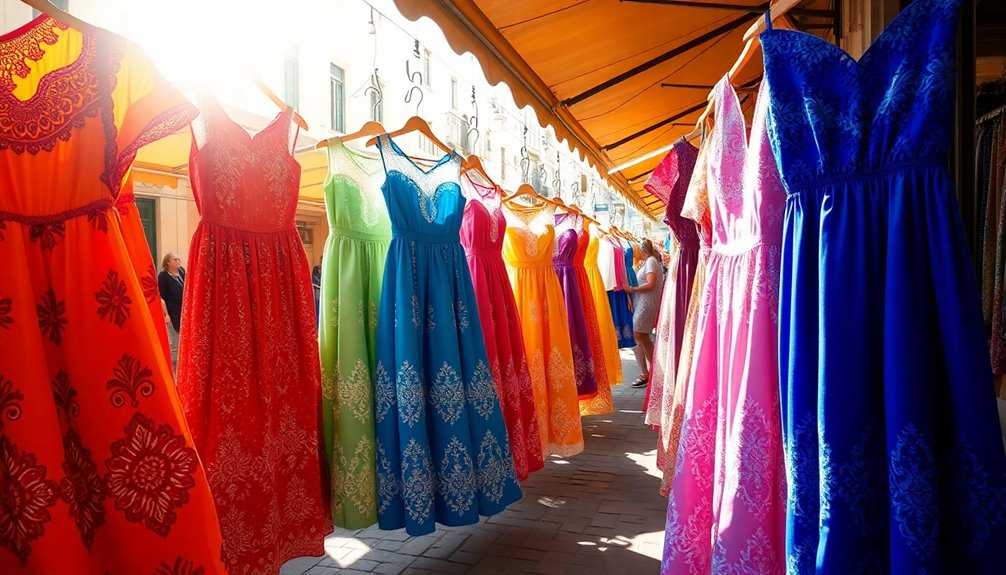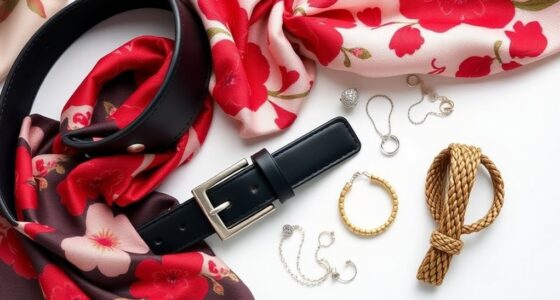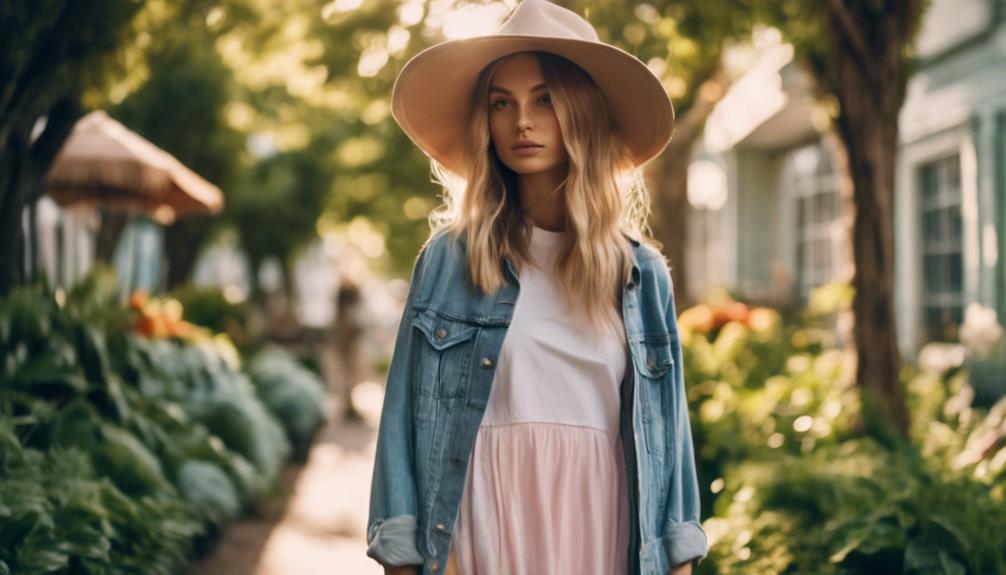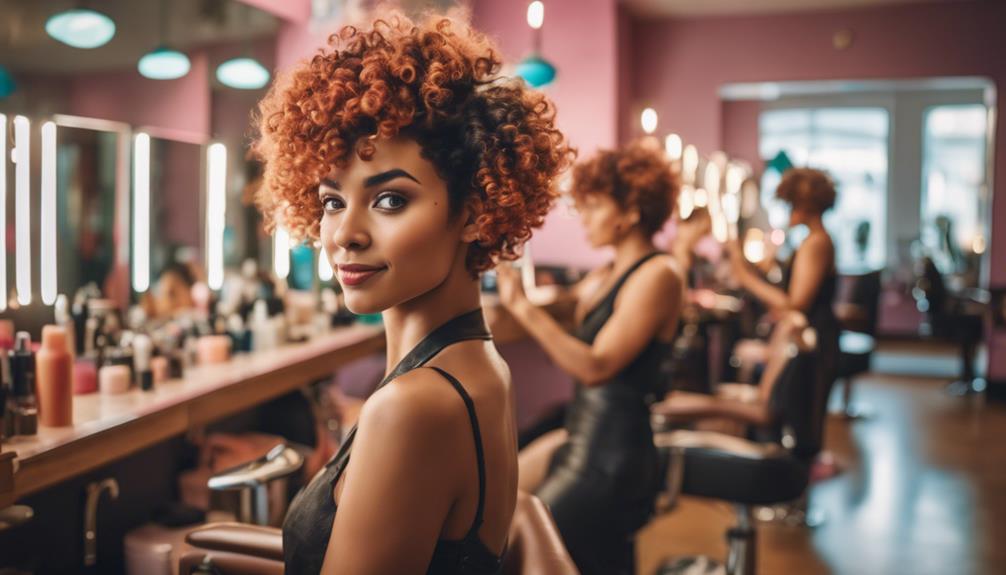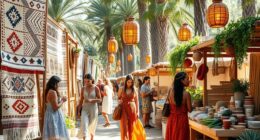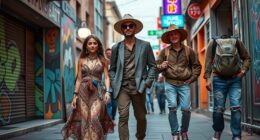When you explore Spain's vibrant markets, you'll uncover a dazzling array of dresses that reflect the nation's unique culture and history. From the colorful flamenco dresses to contemporary styles, each piece showcases intricate patterns and textures. Shops like El Rastro offer one-of-a-kind finds, while boutiques provide high-quality options for those looking to elevate their wardrobe. You can even rent flamenco dresses for special occasions. As you navigate these markets, you'll experience the artistry and craftsmanship behind every garment, which are steeped in tradition. By exploring further, you'll discover even more about the influence of local fashion in Spain.
Key Takeaways
- Explore El Rastro Market, the oldest open-air market in Spain, for unique dresses and accessories every Sunday.
- Flamenco dress boutiques like Sonibel offer high-end selections, while Almacenes Velasco provides DIY materials at accessible prices.
- Second-hand shops such as Libélula and local flea markets feature vintage treasures for budget-conscious shoppers.
- Bright, breathable cotton fabrics dominate summer fashion, with dresses priced between €30 to €100, supporting local artisans.
- Upcycling vintage fabrics is a sustainable choice for creating unique dresses, reflecting Spain's commitment to eco-friendly fashion practices.
Origin and historical background of the fashion trend/style
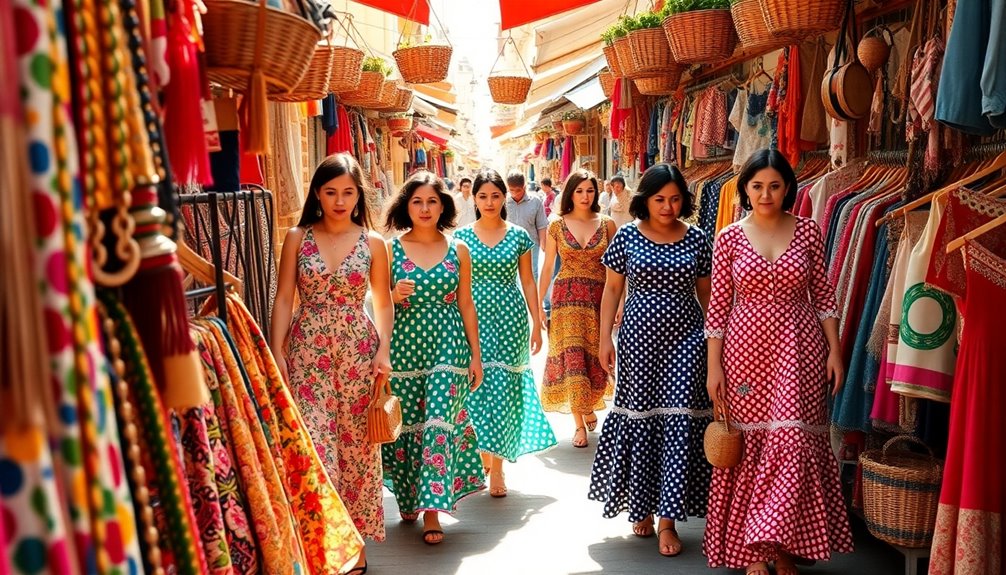
When you look at the evolution of fashion in Spain, you'll notice its transformation from the opulent styles of the 16th century to the modern influences we see today.
Iconic figures, like Spanish designers and celebrities, have played a crucial role in shaping these trends and reviving interest in traditional garments.
Understanding this journey helps you appreciate how Spain's rich cultural heritage continues to influence contemporary fashion.
Fashion's Transformation Over Decades
Fashion in Spain has undergone remarkable transformations over the centuries, reflecting the country's rich cultural tapestry and historical shifts.
In the 16th century, Spanish fashion gained prominence with innovations like the farthingale, which accentuated hourglass silhouettes, and the trend of black clothing that symbolized sophistication during Philip II's reign.
However, the 17th century saw a stagnation, as French and English styles dominated.
The revival began in the 1980s, fueled by youth culture and the emergence of international brands.
Local designers re-emerged during this time, revitalizing Spanish fashion with their unique perspectives and creativity.
Cristobal Balenciaga, a pivotal figure, established his shop in 1916, becoming renowned for his architectural designs in Paris couture.
Fashion Icons of Spain
Spain's fashion scene is marked by a rich lineage of influential figures who've shaped its identity over the years. The historical roots of Spanish style trace back to the 16th century, characterized by elaborate garments like the farthingale, which created those iconic hourglass silhouettes.
Fast forward to the 20th century, and you'll find Cristobal Balenciaga revolutionizing fashion in Paris with his innovative fabrics and architectural designs, setting the stage for modern fashion globally.
The 1980s saw a resurgence of Spanish fashion, fueled by youth culture and the rise of homegrown fashion brands. Designers like Paco Rabanne and Ágatha Ruíz de la Prada emerged, blending traditional elements with contemporary aesthetics, earning international acclaim and further enriching the Spanish style narrative.
Today, Spain's fashion industry thrives with prominent brands like Zara and Mango, which balance affordability with cutting-edge design. These brands reflect a vibrant mix of cultural influences and global trends, showcasing how Spanish fashion continues to evolve while honoring its historical roots. Additionally, the use of sustainable materials in Spanish fashion aligns with eco-friendly choices that are increasingly important in today's market.
You can see this evolution in the streets, where timeless elegance meets modern flair, creating an exciting fashion landscape.
Key Characteristics

When you explore Spanish dresses, you'll notice their vibrant patterns and textures that truly stand out.
The use of bright, breathable cotton fabrics ensures comfort while maintaining style, perfect for warm celebrations.
Plus, traditional Spanish shawls add an elegant touch, enhancing the overall look of any outfit.
Vibrant Patterns and Textures
Dresses in Spain are renowned for their vibrant patterns and textures, offering a feast for the eyes with bright colors and bold designs that capture the essence of the country's lively culture.
You'll notice that Spanish dresses often feature intricate designs, especially during the summer months, when lively hues take center stage. Flamenco dresses exemplify this, showcasing unique styles that include ruffles and layers, which not only enhance movement but also add depth to the overall aesthetic.
As you explore Spanish markets, you'll find a delightful variety of patterns, from floral prints to geometric designs, each reflecting regional influences and cultural heritage.
Accessories play a crucial role in complementing these Spanish dresses; shawls, fans, and bold jewelry introduce additional layers of texture and visual interest.
Whether you're attending a festive occasion or enjoying a casual day out, the vibrant patterns and textures in Spanish fashion invite you to express your individuality and embrace the spirited essence of Spain.
With each dress, you're not just wearing fabric; you're celebrating a rich tapestry of culture and tradition.
Bright, Breathable Cotton Fabrics
Bright, breathable cotton fabrics frequently dominate the fashion scene in Spain, especially during the sweltering summer months. These lightweight materials offer comfort and style, making them a go-to choice for navigating the heat.
You'll often find dresses adorned with bright colors and bold patterns, reflecting the vibrant Spanish culture that thrives in cities like Seville and Barcelona.
Cotton dresses are incredibly versatile; you can easily dress them up for an evening event or keep it casual for a daytime outing. Many Spanish designers prioritize high-quality cotton in their collections, ensuring durability without sacrificing chicness.
With prices typically ranging from €30 to €100, you can find something that fits your budget while maintaining a fashionable edge.
Moreover, breathable fabrics like cotton align with sustainable fashion practices. Since it's a natural material, it can be produced using eco-friendly methods, appealing to those of you who care about the environment.
Embracing bright, breathable cotton fabrics not only enhances your wardrobe but also connects you to a culture that celebrates life through color and comfort.
Traditional Spanish Shawls
In addition to vibrant cotton dresses, traditional Spanish shawls, or "mantones de Manila," play a significant role in the fashion landscape of Spain.
These exquisite shawls are often made from quality fabrics like silk or cotton, showcasing intricate floral patterns and vibrant colors that capture the essence of Spanish culture. Measuring around 1.5 to 2 meters in length, they're versatile enough for draping over your shoulders during cultural events or formal occasions.
When it comes to evening wear, heavier shawls are typically preferred, while lighter versions are perfect for daytime outings. Decorative pins are commonly used to secure them in place, adding a touch of elegance to your ensemble.
Beyond their fashionable appeal, shawls also serve practical purposes, providing warmth and modesty, especially when visiting religious sites or attending traditional festivities.
Creating these traditional Spanish shawls involves weeks of craftsmanship, with skilled artisans employing techniques passed down through generations. Each piece reflects Spain's rich cultural heritage, making them not just an accessory but a statement of history and artistry.
You'll find that wearing a mantón de Manila is more than style; it's about embracing a timeless tradition.
Modern Interpretation

As you explore modern Spanish dresses, you'll notice how sustainable fashion movements are reshaping the industry.
Renowned labels and influential designers are blending eco-friendly practices with contemporary styles, making fashion more responsible and stylish.
Whether it's through recycled materials or unique artisan finds, there's a vibrant narrative behind today's dresses that you're sure to appreciate.
Sustainable Fashion Movements
Sustainable fashion movements in Spain are shaking up the industry by blending style with environmental responsibility. Brands like Mango and Stradivarius are stepping up, incorporating eco-friendly materials and ethical production practices into their clothing lines. This shift showcases a commitment to sustainable fashion that resonates with today's conscious consumers.
One standout in this arena is Ecoalf, which utilizes recycled materials in its collections, actively promoting environmental responsibility. Meanwhile, NAE takes a unique approach by emphasizing vegan fashion choices, using low-impact resources like cork. This intersection of style and sustainability reflects the evolving landscape of modern Spanish fashion.
You'll also notice that local markets in Spain play a crucial role in this movement. They offer not just unique fashion pieces but also support artisan-crafted items, embodying the essence of local culture.
By prioritizing eco-friendly practices, these markets help sustain local economies while encouraging shoppers to make mindful choices.
As you explore the vibrant fashion scene, you'll find that sustainable fashion isn't just a trend; it's a movement that's reshaping how you think about clothing and its impact on the world.
Renowned Spanish Fashion Labels
Spanish fashion labels have carved out a niche that effortlessly combines affordability with modern style. Brands like Zara, Mango, and Massimo Dutti lead the charge, offering clothing options that cater to various tastes and budgets.
At Zara, you can find trendy pieces with prices starting as low as €8.90, and their bi-weekly collection updates ensure you always have fresh styles on hand.
Mango stands out with a diverse selection of stylish separates and dresses, typically starting around €19.99, perfect for everything from casual outings to formal events.
If you're after a more feminine and bohemian vibe, Stradivarius has you covered, with prices beginning at €14.90, appealing to budget-conscious shoppers.
What's more, many Spanish brands are making strides toward sustainability. Labels like Ecoalf and NAE are focusing on eco-friendly materials and ethical production practices, meaning you can feel good about your fashion choices.
Whether you're updating your wardrobe or searching for that perfect dress, these renowned Spanish fashion labels offer a blend of style, affordability, and conscious consumerism, making them must-visit destinations in the fashion world.
Spanish Fashion Influencers
The influence of fashion in Spain extends beyond established brands, with a vibrant community of influencers shaping modern styles.
You'll find that influencers like Juan Varela Duarte emphasize personal expression through vibrant colors and unique outfits, showcasing the diverse street style found in places like El Rastro Market in Madrid.
Ariadna dives into second-hand shops, promoting sustainable fashion choices while highlighting the eclectic finds available in local markets.
Selina's punk-inspired outfits, adapted for the warm climate, reflect a fusion of modern trends and traditional elements—showing how influencers reinterpret cultural heritage creatively.
Meanwhile, Marina incorporates cultural accessories like Fulani earrings and family bracelets, demonstrating the significance of personal history and identity in contemporary Spanish clothing.
Additionally, the rise of influencers like Montse, who prioritize comfort and embrace alternative styles, indicates a shift toward more inclusive and diverse representations of fashion in Spain.
You can see that these influencers aren't just setting trends; they're also fostering a deeper connection between style, sustainability, and cultural identity in the ever-evolving landscape of Spanish fashion.
Styling Tips
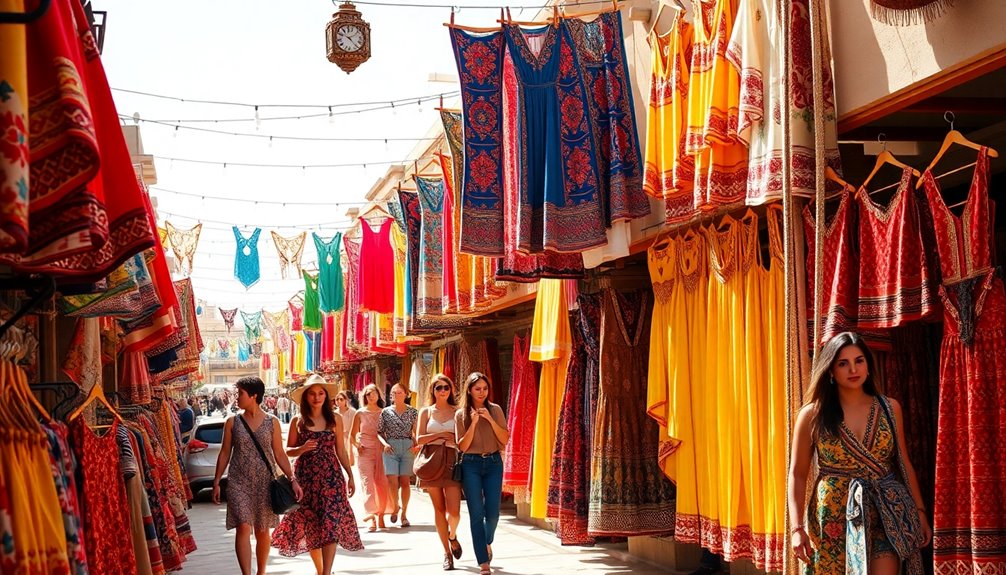
When you're exploring Spain, consider incorporating classic Spanish espadrilles into your wardrobe for both style and comfort.
You can also play with flamenco-inspired ensembles that highlight vibrant prints while ensuring you layer creatively for those cooler evenings.
With these tips, you'll not only look great but also embrace the rich cultural flair of Spanish fashion.
Classic Spanish Espadrilles
With their lightweight design and breathable fabric, classic espadrilles are perfect for warm weather styling. Traditionally made from canvas or cotton with a jute rope sole, these shoes are comfortable and ideal for those sunny days.
You'll find them in various styles, including flats, wedges, and sandals, making them versatile enough to pair with casual dresses, shorts, or beachwear.
When you're choosing your outfit, consider ankle-length or cropped trousers to highlight your espadrilles. This combination not only showcases the footwear but also creates a chic, balanced look.
Alternatively, flowing maxi dresses work beautifully with classic espadrilles for a laid-back vibe that exudes effortless elegance.
Don't forget to embrace the colorful designs and patterns that reflect the vibrant aesthetics of Spanish fashion. Brands like Castañer and Soludos offer options that cater to different budgets, ensuring you can find the perfect pair without breaking the bank.
Whether you're dressing up for a festive occasion or simply enjoying a day out, classic espadrilles can elevate your outfit while keeping you comfortable and stylish. Incorporating elements of modern farmhouse style into your wardrobe can further enhance your overall aesthetic.
Flamenco-Inspired Ensemble Suggestions
Embracing the vibrant spirit of flamenco can transform your wardrobe into a celebration of culture and style. Flamenco dresses, with their unique styles and bold designs, are a fantastic way to express yourself.
Consider investing in a dress that suits your body type and personal taste, as they typically range from €100 to €1,000. If budget's a concern, explore renting options or hunting for secondhand treasures at flea markets.
To complete your look, accessorize wisely. A lightweight shawl works beautifully for daytime events, while a heavier shawl adds sophistication for evening outings. Colorful earrings and necklaces will draw attention, and don't forget a decorative fan for that authentic touch.
High heels are a must; they enhance the dress's length and elevate your whole ensemble. For a playful twist, incorporate traditional floral headpieces, which are gaining popularity for their vibrancy.
Top designers like Aurora Gaviño and Pilar Rubio offer exquisite pieces that reflect cultural significance, but you can also add a personalized touch with DIY options. Embrace flamenco fashion and let your unique style shine!
Layering Vibrant Prints Creatively
Layering vibrant prints creatively can elevate your style and showcase the lively essence of Spanish fashion. Embrace bold colors and unique patterns, especially during summer when vibrant prints flourish in local markets.
Start with a patterned dress as your base; it serves as a canvas for your layered look. Pair it with a solid-colored jacket or a lightweight scarf to add depth and versatility.
When mixing prints, stick to a cohesive color palette to ensure your combinations harmonize instead of clash. This way, you can confidently mix florals with stripes or polka dots without overwhelming your outfit.
Don't forget to accessorize! Colorful jewelry and stylish hats can enhance your layered looks while reflecting the eclectic styles seen in Spanish street fashion.
Look for unique pieces at local markets like El Rastro, where second-hand treasures await. These distinctive finds can add character to your outfits and make your style truly one-of-a-kind. Additionally, practicing self-care techniques can help you feel more confident as you express your unique style through fashion.
Shopping Guide

When you're in Spain and on the hunt for dresses, you'll find a vibrant array of options that cater to every style and budget.
Start your journey at El Rastro Market in Madrid, the oldest open-air market in Spain. Every Sunday, you can explore unique dresses and accessories while soaking in the cultural atmosphere.
If you're after flamenco dresses, visit boutiques like Sonibel for high-end selections or Almacenes Velasco for DIY materials at more affordable prices.
For those special occasions like the Feria de Abril, consider renting a dress. Services like Alpagui offer stylish options complete with accessories, making it a practical choice for travelers.
Don't overlook second-hand shops and flea markets such as Libélula, perfect for budget-conscious shoppers searching for unique dresses and vintage treasures.
Across Spain, local markets are treasure troves of distinctive fashion pieces, typically priced between €10 and €50.
This not only allows you to snag a great deal but also supports local artisans.
With so many options, you're sure to find the perfect dress that fits your style and budget.
Handmade Embellishments for Dresses
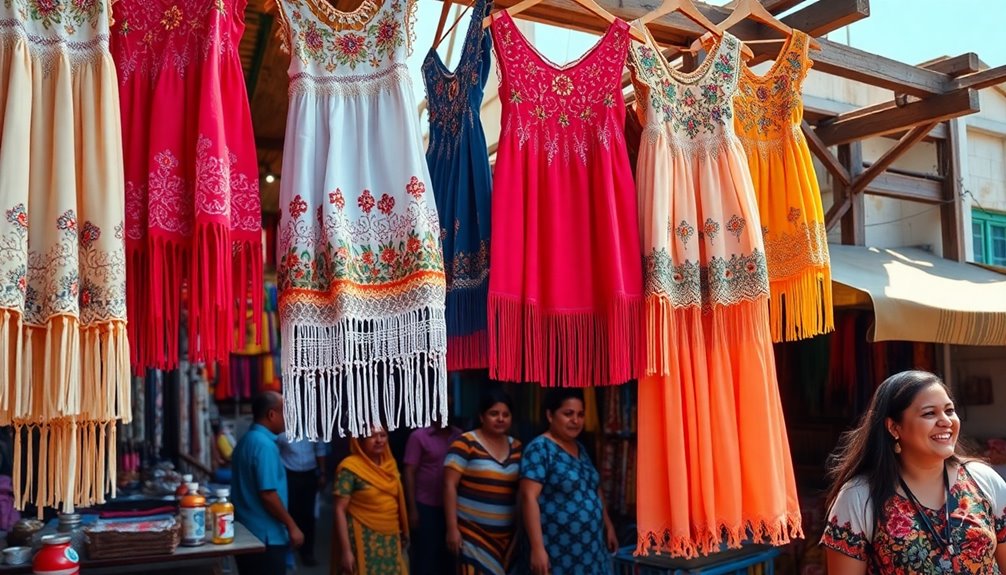
When you're looking to add a personal touch to your dress, consider upcycling vintage fabrics and incorporating local textile patterns.
These handmade embellishments not only bring character to your outfit but also connect you to Spain's rich cultural heritage.
Upcycle Vintage Fabrics
Upcycling vintage fabrics offers a sustainable way to create stunning, one-of-a-kind dresses that reflect your personal style. By incorporating historical textiles, you not only reduce waste in the fashion industry but also celebrate the craftsmanship of the past.
You can find an array of vintage fabrics at local markets like El Rastro in Madrid, where you're sure to discover unique materials perfect for your projects.
Adding handmade embellishments, such as lace trims or embroidered patches, can elevate your upcycled dresses even further. These details allow you to express your creativity and individuality, making each dress a true reflection of who you are.
When you upcycle vintage fabrics, you support ethical and sustainable practices that benefit local artisans and help preserve traditional textile techniques. Incorporating unique materials into your designs not only enhances their beauty but also aligns with the principles of sustainable fashion.
Each piece you create tells a story, intertwining the old with the new. You'll feel proud knowing your dress minimizes environmental impact while showcasing your unique design aesthetics.
Incorporate Local Textile Patterns
Incorporating local textile patterns into your dresses instantly adds a touch of Spanish culture and artistry. Spanish fashion thrives on vibrant colors and intricate designs that reflect the rich regional heritage of the country. By choosing dresses embellished with handmade elements, like embroidery and lace from Andalusia, you elevate the garment's cultural significance and uniqueness.
Traditional techniques, such as silk and cotton fabrics, are commonly used in creating flamenco dresses that showcase local artisanal skills. When you shop at regional markets in Seville and Madrid, you'll discover dresses adorned with these distinctive local patterns, allowing you to connect directly with Spanish culture and style.
Many Spanish designers prioritize sustainable practices, using organic materials and supporting local artisans. This not only ensures that your clothing is eco-friendly but also helps preserve traditional craftsmanship.
As you explore these vibrant markets, look for one-of-a-kind pieces that incorporate local textile patterns and handmade embellishments, making your wardrobe a true reflection of Spain's artistic spirit. By embracing these elements in your clothing, you celebrate the beauty of Spain while wearing unique, culturally rich dresses.
Cultural Impact

When you watch Spanish films, you'll notice how fashion plays a crucial role in storytelling, reflecting both cultural pride and contemporary trends.
Fashion activism in Spain also highlights the importance of ethical practices and sustainability, showing how clothing can be a form of expression and change.
Together, these elements underscore the deep cultural impact that fashion has in Spanish society.
Spanish Films Showcasing Fashion
How do Spanish films reflect the country's rich fashion heritage? They serve as vibrant showcases of personal style, encapsulating the essence of regional fashion.
Take "Carmen," for instance; its stunning flamenco dresses are a visual celebration of Andalusian culture. You can almost feel the rhythm of the dance through the fabric.
Then there's "Volver," directed by Pedro Almodóvar, where contemporary outfits blend traditional elements with modern trends, portraying the modern Spanish woman's fashion sensibility.
In "The Flower of My Secret," costuming becomes a narrative tool, expressing the emotional depth of its protagonist through bold colors and unique patterns that highlight Spanish fashion's artistic flair.
Meanwhile, "Belle Époque" uses period costumes to illustrate cultural shifts in early 20th-century Spain, further enriching your understanding of the nation's fashion evolution.
Moreover, the influence of iconic Spanish designers like Balenciaga and Rabanne can't be overlooked. Their styles permeate various films, reinforcing Spain's influential role in the global fashion narrative.
Fashion Activism in Spain
Fashion activism in Spain has emerged as a dynamic force, driven by local designers and brands that prioritize cultural heritage and sustainability. You'll notice how these fashion choices reflect a commitment to ethical production practices, inspiring you to engage in conscious consumerism.
Traditional garments, like flamenco dresses, highlight regional variations and serve as powerful symbols of cultural expression and preservation.
Spanish fashion weeks in cities like Madrid and Barcelona offer platforms for emerging designers to spotlight pressing social issues, advocate for inclusivity, and challenge conventional beauty standards. This environment encourages you to appreciate the depth of what fashion can represent beyond mere aesthetics.
Initiatives like Ecoalf and NAE focus on sustainable fashion, using recycled materials and vegan options, aligning with a growing movement toward environmental responsibility in the industry.
When you explore local markets like El Rastro in Madrid, you not only find unique fashion pieces but also participate in a cultural exchange that empowers artisans.
Through these efforts, Spanish fashion is gaining global recognition, illustrating how you can be part of a more sustainable and culturally rich narrative in the fashion world while making impactful choices. Additionally, the fashion industry is becoming increasingly aware of its environmental impact, paralleling the rise of renewable energy innovations that seek to reduce carbon footprints across various sectors. As designers prioritize ethical practices, consumers are encouraged to make informed choices that align with sustainability and cultural appreciation. This shift not only challenges traditional norms but also addresses the fast fashion environmental impact that has long plagued the industry. By supporting brands that emphasize quality and longevity over quick trends, shoppers can contribute to a more responsible fashion ecosystem that respects both our planet and its diverse heritage.
Frequently Asked Questions
What Is the Most Famous Dress in Spain?
The most famous dress in Spain is the traditional flamenco dress. Known for its vibrant colors and intricate ruffles, it captures the essence of Spanish culture.
You'll find these dresses worn during festivals and celebrations, each uniquely styled to fit different occasions. Prices usually range from €100 to €1,000, reflecting their craftsmanship.
Accessorizing with shawls, fans, and flowers enhances your look, making the flamenco dress a true symbol of Spanish heritage.
What Is the Most Popular Fashion Brand in Spain?
The most popular fashion brand in Spain is Zara.
You'll find Zara's trendy collections changing bi-weekly, making it a go-to for fashion-forward shoppers. With prices starting as low as €8.90, it caters to a wide audience.
If you're looking for stylish yet affordable options, Zara's diverse range won't disappoint. You can easily keep your wardrobe fresh and on-trend without breaking the bank.
Explore their latest styles to elevate your fashion game!
How Do You Dress in Spain and Not Look Like a Tourist?
To dress in Spain without looking like a tourist, choose stylish, well-fitted clothing made from lightweight fabrics.
Ditch typical tourist accessories like fanny packs; opt for a small crossbody bag instead.
When visiting religious sites, cover your shoulders and legs to respect local customs.
Pay attention to regional styles—Barcelona's modern looks differ from Seville's flamenco flair.
Embrace bold colors and patterns, ensuring your outfits are practical for various activities throughout your adventures.
What Is the Dress Style in Spain?
In Spain, you'll find a vibrant mix of styles that reflect both tradition and modernity. You can wear bold colors and unique patterns, especially during special occasions like festivals.
Flamenco dresses are popular, showcasing elaborate designs. For everyday wear, opt for chic yet affordable options from local brands like Zara or Mango.
Don't forget to layer for cooler evenings, and embrace lightweight fabrics for the warm summer days.
